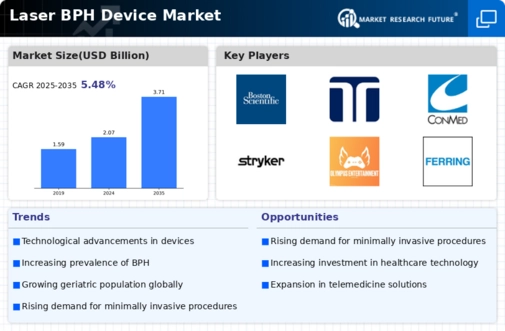Rising Prevalence of BPH
The increasing prevalence of Benign Prostatic Hyperplasia (BPH) among the aging male population is a primary driver of the Global Laser BPH Device Market Industry. As men age, the likelihood of developing BPH rises significantly, leading to a greater demand for effective treatment options. In 2024, the market is projected to reach 2.07 USD Billion, reflecting the urgent need for innovative solutions. This trend is expected to continue, with the market anticipated to grow to 3.71 USD Billion by 2035, indicating a robust CAGR of 5.46% from 2025 to 2035. Such growth underscores the critical role of laser devices in managing BPH symptoms.
Market Growth Projections
The Global Laser BPH Device Market Industry is projected to experience substantial growth over the coming years. In 2024, the market is expected to reach 2.07 USD Billion, with forecasts suggesting it could expand to 3.71 USD Billion by 2035. This growth trajectory indicates a compound annual growth rate (CAGR) of 5.46% from 2025 to 2035. Such projections reflect the increasing adoption of laser technologies in BPH treatment, driven by factors such as technological advancements, rising prevalence of BPH, and growing patient awareness. These metrics suggest a robust future for the laser BPH device market.
Technological Advancements
Technological advancements in laser therapy techniques are significantly influencing the Global Laser BPH Device Market Industry. Innovations such as Holmium Laser Enucleation of the Prostate (HoLEP) and Photoselective Vaporization of the Prostate (PVP) enhance treatment efficacy and reduce recovery times. These advancements not only improve patient outcomes but also attract healthcare providers to adopt laser devices over traditional surgical methods. As a result, the market is poised for growth, with projections indicating a rise from 2.07 USD Billion in 2024 to 3.71 USD Billion by 2035. The continuous evolution of laser technologies suggests a promising future for the industry.
Minimally Invasive Procedures
The shift towards minimally invasive procedures is a significant driver of the Global Laser BPH Device Market Industry. Patients increasingly prefer treatments that offer reduced recovery times and lower risks of complications. Laser BPH devices provide effective solutions that align with this trend, allowing for outpatient procedures that minimize hospital stays. This preference is reflected in the market's growth trajectory, with an expected increase from 2.07 USD Billion in 2024 to 3.71 USD Billion by 2035. The anticipated CAGR of 5.46% from 2025 to 2035 further emphasizes the potential for laser devices to dominate the BPH treatment landscape.
Growing Awareness and Education
Growing awareness and education regarding BPH and its treatment options are pivotal in driving the Global Laser BPH Device Market Industry. Increased public health campaigns and educational initiatives by healthcare organizations are informing patients about the benefits of laser treatments. As awareness rises, more patients are likely to seek medical advice and treatment for BPH, thereby increasing demand for laser devices. This trend is expected to contribute to the market's growth, with projections indicating an increase from 2.07 USD Billion in 2024 to 3.71 USD Billion by 2035. The anticipated CAGR of 5.46% from 2025 to 2035 highlights the potential for sustained market expansion.
Increasing Healthcare Expenditure
Rising healthcare expenditure globally is contributing to the expansion of the Global Laser BPH Device Market Industry. As countries allocate more resources to healthcare, there is a greater emphasis on advanced medical technologies, including laser devices for BPH treatment. This trend is particularly evident in developed regions, where healthcare budgets are robust. The market is projected to grow from 2.07 USD Billion in 2024 to 3.71 USD Billion by 2035, driven by increased investments in healthcare infrastructure and technology. This financial commitment suggests a favorable environment for the adoption of laser BPH devices.







